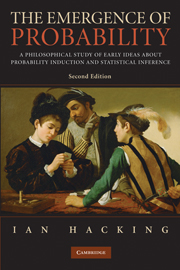 The Emergence of Probability
The Emergence of Probability Book contents
- Frontmatter
- Contents
- Introduction 2006
- 1 An absent family of ideas
- 2 Duality
- 3 Opinion
- 4 Evidence
- 5 Signs
- 6 The first calculations
- 7 The Roannez circle (1654)
- 8 The great decision (1658?)
- 9 The art of thinking (1662)
- 10 Probability and the law (1665)
- 11 Expectation (1657)
- 12 Political arithmetic (1662)
- 13 Annuities (1671)
- 14 Equipossibility (1678)
- 15 Inductive logic
- 16 The art of conjecturing (1692[?] published 1713)
- 17 The first limit theorem
- 18 Design
- 19 Induction (1737)
- Bibliography
- Index
16 - The art of conjecturing (1692[?] published 1713)
Published online by Cambridge University Press: 05 April 2013
- Frontmatter
- Contents
- Introduction 2006
- 1 An absent family of ideas
- 2 Duality
- 3 Opinion
- 4 Evidence
- 5 Signs
- 6 The first calculations
- 7 The Roannez circle (1654)
- 8 The great decision (1658?)
- 9 The art of thinking (1662)
- 10 Probability and the law (1665)
- 11 Expectation (1657)
- 12 Political arithmetic (1662)
- 13 Annuities (1671)
- 14 Equipossibility (1678)
- 15 Inductive logic
- 16 The art of conjecturing (1692[?] published 1713)
- 17 The first limit theorem
- 18 Design
- 19 Induction (1737)
- Bibliography
- Index
Summary
Jacques Bernoulli's Ars conjectandi presents the most decisive conceptual innovations in the early history of probability. The author died in 1705. He had been writing the book off and on for twenty years. Although the chief theorem was proved in 1692, he was never satisfied and he never published. The work was finally given to the printer by his nephew Nicholas, and appeared in Basle in 1713. In that year probability came before the public with a brilliant portent of all the things we know about it now: its mathematical profundity, its unbounded practical applications, its squirming duality and its constant invitation for philosophizing. Probability had fully emerged.
The chief mathematical contribution of the book is plain enough: the first limit theorem of probability. This result has rightly been given the seal of A. N. Kolmogorov as being proven by Bernoulli with ‘full analytical rigour’ [Maistrov, 1974, p. 75]. But what the theorem means is another question. We shall try to find out in the next chapter. First it is worth investigating Bernoulli's own conception of probability. Since we still lack universal agreement on the analysis of probability no one writes dispassionately about the man. He has been fathered with the first subjective conception of probability. Yet Richard von Mises [1951] could cast him as a stalwart frequentist. More recent statisticians such as A. P. Dempster [1966] say he anticipated Jerzy Neyman's approach to inference via confidence intervals.
- Type
- Chapter
- Information
- The Emergence of ProbabilityA Philosophical Study of Early Ideas about Probability, Induction and Statistical Inference, pp. 143 - 153Publisher: Cambridge University PressPrint publication year: 2006
